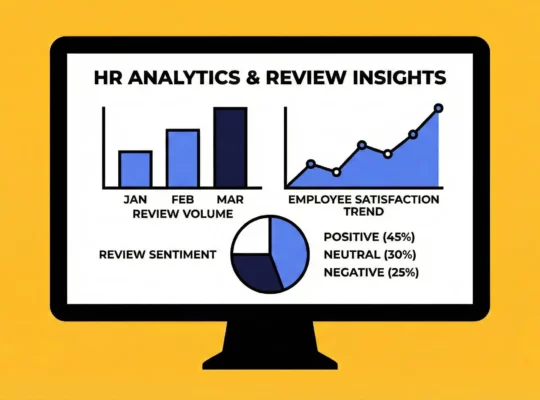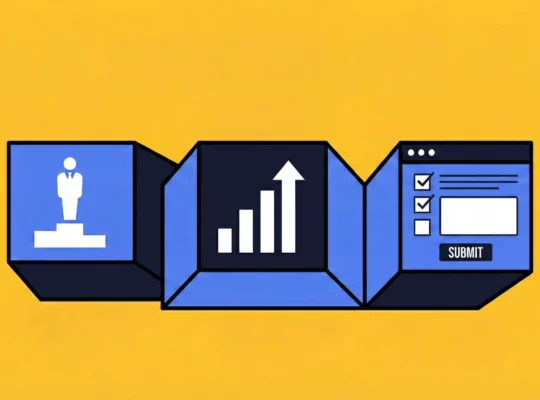Imagine your team operating at peak performance – exceeding goals, brimming with ideas, and constantly pushing boundaries. Performance improvement is the secret key that unlocks this potential. It’s not about playing detective to find flaws, it’s about empowering individuals and teams to achieve greatness.
Review.jobs understands that growth isn’t just about fixing problems, it’s about transforming potential into excellence. Through clear expectations, insightful feedback, and targeted improvement plans, we help businesses create a culture of continuous learning and achievement. Ready to see your team soar? Let’s dive into the world of performance improvement and unlock the secrets to operational, strategic, and service success!
Table of Contents
I. Understanding Performance Improvement
II. Importance of Performance Improvement
III. Performance Improvement Plans (PIPs): A Roadmap to Succes
IV. Measuring Performance Improvement
V. Common Pitfalls and How to Avoid Them
VI. Driving Performance Improvement with Review.jobs
I. Understanding Performance Improvement
Performance improvement encompasses a systematic approach to enhancing the efficiency and effectiveness of employee performance within a company. Unlike performance management, which generally focuses on aligning an individual’s work with organizational goals and tracking their progress, performance improvement is proactive and constructive, aiming to elevate employees’ abilities to achieve higher work standards.
Performance improvement can be applied at various levels within an organization:
- Individual performance: At the individual level, it targets enhancing each employee’s skills and productivity through tailored improvement plans and one-on-one feedback sessions. This approach helps address specific performance issues and guides employees toward personal development and career advancement.
- Team performance: At the team level, performance improvement focuses on enhancing the dynamics and output of group efforts. This might involve collaborative improvement plans, team-building exercises, and regular performance reviews that encourage mutual support and alignment with team goals.
- Organizational performance: On a broader scale, organizational performance improvement involves aligning the improvement plans of individual team members and entire departments with the strategic objectives of the company. It requires robust performance management systems and well-structured corporate improvement plans to ensure that all parts of the organization work cohesively towards common goals.
II. Importance of Performance Improvement
The payoff for smart performance improvement strategies is huge. We’re talking happier employees who get more done and a strategically unstoppable company.
1. Higher Productivity and Better Efficiency
Did you know happy employees are money in the bank? According to Gallup research, companies with highly engaged teams enjoy a whopping 21% profitability boost and a 17% jump in productivity compared to those with uninspired workers. By focusing on tailored improvement plans and ongoing performance management, companies can cultivate an environment that maximizes employee performance and efficiency, leading to better outcomes and higher profitability.
2. Sparked Employee Satisfaction
By investing in your people’s growth and development, you send a clear message: “You matter.” When employees see opportunities to learn, excel, and contribute meaningfully, their happiness and engagement naturally rise. This translates to a positive work environment, stronger relationships within the team, and a more productive organization overall.
Asking the right questions in your satisfaction surveys is crucial. Instead of generic options, dig deeper to understand what truly motivates your team. What kind of growth opportunities would they value most? How can you better recognize their achievements?
3. Reduced Absenteeism and Lower Turnover
Effective performance improvement keeps your team healthy and happy, which means less absenteeism and lower turnover. That translates to a stable, experienced workforce – a dream for any business leader!
According to Deloitte Global’s 2021 Millennial study, a significant portion of the workforce is at risk of turnover, with 36% of millennials and 53% of Gen Z respondents globally planning to leave their employers within two years.
Additionally, research by the Society for Human Resource Management (SHRM) indicates that productivity can decrease by about 30% when employees are covering for absent coworkers.
Addressing the root causes of dissatisfaction and disengagement through proactive improvement plans can help reduce these numbers significantly, ensuring a more dedicated and stable workforce.
4. Organizational Growth and Competitiveness
Beyond the immediate benefits, performance improvement is strategically important for organizational growth and competitiveness. In a rapidly evolving business environment, companies that consistently invest in enhancing the capabilities and engagement of their team members are better positioned to innovate and capitalize on new opportunities.
Effective performance improvement aligns the development of individual talents with the strategic goals of the organization, thereby enhancing overall competitiveness and readiness to meet future challenges.
III. Performance Improvement Plans (PIPs): A Roadmap to Success
Ever feel like you and your employee are on different pages? Maybe deadlines are missed, or goals aren’t quite being met. Performance Improvement Plans (PIPs) can be the bridge that gets you back on track.
What Is a Performance Improvement Plan?
A Performance Improvement Plan (PIP) is a formal document that outlines the required improvement in an employee’s performance. The primary purpose of a PIP is to facilitate clear internal communication between an employee and management regarding performance deficiencies and to establish a clear action plan for improvement. It clarifies expectations, outlines clear goals, and provides a step-by-step approach to achieving them.
Key Components of an Effective PIP
- Clear objectives and expectations: The PIP should define specific, measurable, achievable, relevant, and time-bound (SMART) goals that provide a clear direction for the employee.
- Support structures and resources: It’s essential to provide employees with the necessary resources to succeed. This includes training, access to mentoring, and employee review management platforms like Review.jobs.
- Regular feedback and review mechanisms: Continuous dialogue is vital. Scheduled reviews and informal check-ins help keep the improvement plan on track and can address any emerging challenges promptly.
When to Use a Performance Improvement Plan (PIP) vs. When to Look for Other Solutions
| Scenario | Use a PIP | Look for Other Solutions |
| Clear Performance Gap (despite clear job description and feedback) | ✓ | |
| Opportunity for Growth (employee has potential with additional support) | ✓ | |
| Preventing Termination (PIP as a chance to improve before dismissal) | ✓ | |
| Skills Mismatch (employee struggling due to role not aligning with skills/career goals) | ✓ (consider role realignment or career development) | |
| External Factors (temporary personal issue impacting performance) | ✓ (address root cause) |
IV. Measuring Performance Improvement
To effectively drive and assess performance improvement, organizations must utilize specific indicators and tools that allow for both broad overviews and detailed analyses of employee outputs and behaviors.
A. Key Performance Indicators (KPIs) to Track Performance
1. Productivity Metrics
This can include output per hour or quality of work, depending on the job role. These metrics help gauge how effectively individuals or teams are meeting their performance expectations.
2. Employee Engagement Scores
Engagement levels are directly tied to performance. Higher engagement scores usually indicate a more committed and productive workforce.
If your company is struggling to meet satisfactory engagement scores, don’t hesitate to invest in the right employee engagement programs to give your team the boost they need.
3. Customer Satisfaction Rates
For roles that interact with customers, satisfaction metrics provide insights into how well employees are meeting or exceeding service standards.
B. Tools and Techniques for Assessing Performance
Several tools and techniques can facilitate the effective measurement of performance improvement:
Performance Management with Review.jobs
Platforms like Review.jobs offer digital tools that streamline the tracking of KPIs and performance reviews. These features help companies build a positive employer brand, attract top talent, and improve workplace culture through actionable insights.
360-Degree Feedback
This technique involves gathering feedback from all levels of interaction within the organization, including peers, supervisors, and direct reports, providing a comprehensive view of an employee’s performance.
Self-Assessment
Encouraging employees to self-evaluate can provide valuable insights into their perspectives on their own performance and aspirations. They gain valuable insights into their strengths and weaknesses, and you gain a deeper understanding of their career aspirations.
C. Quantitative vs. Qualitative Measures
Quantitative measures might include sales numbers, customer cases handled, or incident reports, which provide tangible data on employee output. Qualitative measures could involve peer reviews, client feedback, or creativity and initiative, offering more subjective insights into employee qualities and behaviors.
V. Common Pitfalls and How to Avoid Them
| Pitfall | How to Avoid It |
| Unclear Communication | Ensure crystal-clear communication of goals, expectations, and feedback. Regular check-ins and open dialogue are key. |
| Inadequate Training or Resources | Invest in proper training and development programs to equip employees with the tools they need to succeed. |
| Focus on Punishment, Not Progress | Frame the PIP as a collaborative effort for improvement, not a punitive measure. |
| Lack of Follow-up and Support | Regularly monitor progress, offer ongoing support, and provide opportunities for feedback throughout the PIP process. |
| Inconsistent Application | Ensure all employees are held to the same performance standards and that PIPs are implemented fairly and consistently. |
VI. Driving Performance Improvement with Review.jobs
Review.jobs has fundamentally changed the game for performance improvement strategies. It creates a space for continuous dialogue between employees and managers, fostering a more transparent and responsive performance management environment.
Review.jobs makes detailed performance analytics accessible to organizations of all sizes. This, along with its features, empowers businesses to:
- Track progress with laser focus: Precise analytics provide a clear picture of performance improvement over time.
- Identify opportunities for intervention: Quickly pinpoint areas where employees need support, allowing for timely action.
- Cultivate a culture of continuous improvement: Encourage ongoing feedback exchange, which is vital for both employee development and organizational success.
We’ve shown you powerful strategies, from tailored PIPs to company-wide alignment. Invest in continuous learning and adopt flexible models to empower your workforce. It’s the key to navigating challenges, thriving in a changing business world, and boosting your employer image as a result. Review.jobs is your partner in this. We equip you with the tools and insights to continuously improve, watch your team flourish, and monitor your online reputation as a top development-focused organization.





